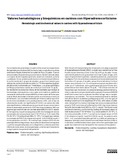| dc.rights.license | http://creativecommons.org/licenses/by-nc-sa/3.0/ve/ | es_VE |
| dc.contributor.author | Guevara-Inga, Carlos Andrés | |
| dc.contributor.author | Campos-Murillo, Nathalie | |
| dc.date.accessioned | 2022-08-01T01:48:03Z | |
| dc.date.available | 2022-08-01T01:48:03Z | |
| dc.date.issued | 2022 | |
| dc.identifier.issn | 0798-2259 | |
| dc.identifier.uri | http://www.saber.ula.ve/handle/123456789/48348 | |
| dc.description.abstract | Con el objetivo de caracterizar el cuadro clínico en perros sospechosos
de hiperadrenocorticismo (HAC) se llevó a cabo un estudio en la clínica
veterinaria Mundo Animal de la ciudad de Puyo, Ecuador. Fueron
seleccionados 23 pacientes que presentaron más de 3 años de edad,
con signos de dermopatías generales, abdomen ondulante, poliuria
y polidipsia. De los análisis preliminares (cortisolemia) permitieron
la conformación de 2 grupos de estudios, grupo A (normales) cuyos
valores de cortisol estuvieron entre 2 a 7,5 microgramos (μg) por
decilitros (dL) conformado por 7 individuos, y un grupo patológico
(n=16) que presentaron niveles de cortisol por encima de 7,5 ug·dL-1.
Se monitoreó la evolución clínica de los animales que incluyó la
hematología y la bioquímica, a los cuales se le realizó un análisis de
varianza de clasificación simple (ANOVA) y el test exacto de Fisher para
evaluar efecto de la edad, el tamaño o peso, la convivencia, el sexo y la
alimentación. Los resultados obtenidos permitieron indicar que entre
los factores estudiados como predisponente a HAC, solo el tipo de
alimentación resultó ser significativo (P<0,02), con valores de odds
ratio significativos, indicando que los que los perros que consumieron
alimento balanceado presentaron 10,67 más veces de padecer HAC que
aquellos que se alimentan con comida casera (88,9 vs 42,9 % casos).
El hemograma y la química sanguínea confirmó el hallazgo de valores
aumentados de la leucocitosis leve (17,18·109·Litros-1 [L]), neutrofilia
(14,30·109·L-1) trombocitosis (664,12 ·109·L-1), al igual que valores
aumentados de FOS (7,49 miligramos (mg)·dL-1) y GLU (126,92 mg·dL-1)
en los pacientes con HAC+. Se concluye que, aunque el HCA es una
patología difícil de diagnosticar, las pruebas de laboratorio (hemograma
y química sanguínea) ayudan en su diagnóstico y además permiten
diferenciar estos casos, de otras patologías y orientar así el tratamiento
a seguir para la recuperación del paciente. | es_VE |
| dc.language.iso | es | es_VE |
| dc.publisher | SaberULA | es_VE |
| dc.rights | info:eu-repo/semantics/openAccess | es_VE |
| dc.subject | Endocrinopatía | es_VE |
| dc.subject | Cushing | es_VE |
| dc.subject | Hipófisodependiente | es_VE |
| dc.subject | Canino | es_VE |
| dc.subject | Dermatológicos | es_VE |
| dc.title | Valores hematológicos y bioquímicos en caninos con Hiperadrenocorticismo | es_VE |
| dc.title.alternative | Hematologic and biochemical values in canines with Hyperadrenacorticism | es_VE |
| dc.type | info:eu-repo/semantics/article | es_VE |
| dc.description.abstract1 | With the aim of characterizing the clinical picture in dogs suspected
of hyperadrenocorticism (HAC), a study was carried out at the
Mundo Animal Veterinary Clinic in the City of Puyo, Ecuador. It was
selected 23 patients who presented more than 3 years of age, with
signs of general dermopathies, undulating abdomen, polyuria and
polydipsia. From the preliminary analyses (cortisolemia) allowed the
formation of 2 groups of studies, group A (normal) whose Cortisol
values were between 2 to 7.5 microgrames (ug) per deciliters (dL)
made up of 7 individuals, and a pathological group (n=13) who also
presented cortisol levels above 7.5 ug·dL-1. The clinical evolution of
the animals was monitored, including hematology and biochemistry,
which underwent a simple classification analysis of variance (ANOVA)
and Fisher’s exact test to evaluate the effect of age, size or weight,
coexistence, sex and diet. The results obtained allowed to indicate
that of the factors studied as predisposing to HAC, only the type of
feeding turned out to be significant (P<0.02), with values of odds
ratio, being that it turned out that dogs that consume balanced food
present 10.67 more times of suffering from HAC than those that are
fed with homemade food (88.9 vs 42.9 % cases). The blood count
and blood chemistry confirmed the finding of increased values of
mild leukocytosis (17.18·109·liters-1 [L], neutrophilia (14.30·109·L-1),
thrombocytosis (664.12·109·L-1), as well as increased values of FOS
(7.49 miligrams (mg)·dL-1) and GLU (126.92 mg·dL-1) in patients with
HAC+. It is concluded that although HAC is a difficult pathology to
diagnose, laboratory tests (blood count and blood chemistry) help in
it and allow to differentiate these cases with other pathologies and
guide the treatment to be followed for the recovery of the patient. | es_VE |
| dc.description.email | andirex9@gmail.com | es_VE |
| dc.identifier.depositolegal | pp199102ZU46 | |
| dc.identifier.edepositolegal | ppi201502ZU4665 | |
| dc.identifier.eissn | 2477-944X | |
| dc.publisher.pais | Venezuela | es_VE |
| dc.subject.institucion | Universidad del Zulia (LUZ) | es_VE |
| dc.subject.institucion | Universidad de Los Andes (ULA) | es_VE |
| dc.subject.keywords | Endocrinopathy | es_VE |
| dc.subject.keywords | Cushing | es_VE |
| dc.subject.keywords | Hypophysis-dependent | es_VE |
| dc.subject.keywords | Canine | es_VE |
| dc.subject.keywords | Dermatological | es_VE |
| dc.subject.publicacionelectronica | Revista Científica | |
| dc.subject.seccion | Revista Científica: Artículos | es_VE |
| dc.subject.thematiccategory | Medio Ambiente | es_VE |
| dc.subject.tipo | Revistas | es_VE |
| dc.type.media | Texto | es_VE |


